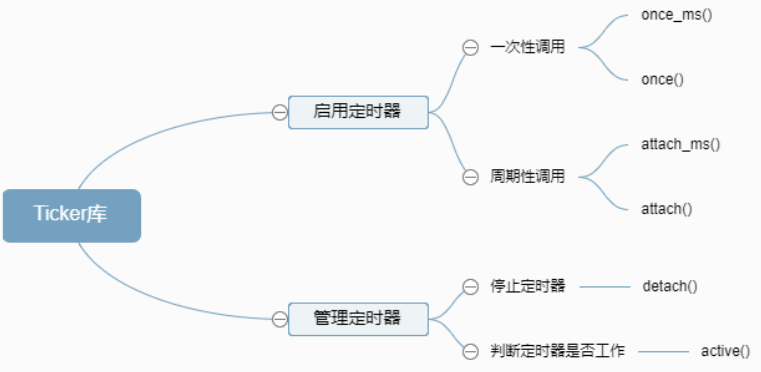ESP8266内置的定时器库--Ticker库

Ticker的功能非常简单,就是规定时间后调用函数

总体上,根据功能可以把方法分为两大类:
定时器管理方法;
定时器启用方法;
detach() 停止定时器
active() 定时器是否工作
返回值 bool
void once(float seconds, callback_function_t callback); xx秒后只执行一次-----不带参数
void once(float seconds, callback_function_t callback,TArg arg); xx秒后只执行一次-----带参数
seconds 秒数
callback 回调函数
arg 是回调函数的参数
void once_ms(float seconds, callback_function_t callback) xx毫秒后只执行一次
void once_ms(float seconds, callback_function_t callback,TArg arg) xx毫秒后只执行一次
void attach(float seconds, callback_function_t callback); 每隔xx秒周期性执行
void attach(float seconds, callback_function_t callback,TArg arg); 每隔xx秒周期性执行
void attach_ms(float seconds, callback_function_t callback); 每隔xx毫秒周期性执行
void attach_ms(float seconds, callback_function_t callback,TArg arg); 每隔xx毫秒周期性执行
注意点:
不建议使用Ticker回调函数来阻塞IO操作(网络、串口、文件);可以在Ticker回调函数中设置一个标记,在loop函数中检测这个标记;
对于arg,必须是 char, short, int, float, void*, char* 之一;
例子一:---不带参数
#include <Ticker.h> //导入定时器库 Ticker flipper; //实例化定时器对象 int count = 0; void flip() { //回调函数 int state = digitalRead(LED_BUILTIN); digitalWrite(LED_BUILTIN, !state); ++count; if (count == 20) { flipper.attach(0.1, flip); //每隔0.1秒执行一次回调函数 } else if (count == 120) { flipper.detach(); } } void setup() { pinMode(LED_BUILTIN, OUTPUT); digitalWrite(LED_BUILTIN, LOW); flipper.attach(0.5, flip);//每隔0.5秒执行一次回调函数 } void loop() { }
例子2-----带参数
#include <Ticker.h> //导入定时器库 Ticker tickerSetHigh; Ticker tickerSetLow; void setPin(int state) { //回调函数--带参数 digitalWrite(LED_BUILTIN, state); } void setup() { pinMode(LED_BUILTIN, OUTPUT); tickerSetLow.attach_ms(25, setPin, 0);//每隔25毫秒调用一次回调函数--带参数 tickerSetHigh.attach_ms(26, setPin, 1); } void loop() { }
天子骄龙









【推荐】国内首个AI IDE,深度理解中文开发场景,立即下载体验Trae
【推荐】编程新体验,更懂你的AI,立即体验豆包MarsCode编程助手
【推荐】抖音旗下AI助手豆包,你的智能百科全书,全免费不限次数
【推荐】轻量又高性能的 SSH 工具 IShell:AI 加持,快人一步
· 基于Microsoft.Extensions.AI核心库实现RAG应用
· Linux系列:如何用heaptrack跟踪.NET程序的非托管内存泄露
· 开发者必知的日志记录最佳实践
· SQL Server 2025 AI相关能力初探
· Linux系列:如何用 C#调用 C方法造成内存泄露
· 震惊!C++程序真的从main开始吗?99%的程序员都答错了
· 别再用vector<bool>了!Google高级工程师:这可能是STL最大的设计失误
· 【硬核科普】Trae如何「偷看」你的代码?零基础破解AI编程运行原理
· 单元测试从入门到精通
· 上周热点回顾(3.3-3.9)